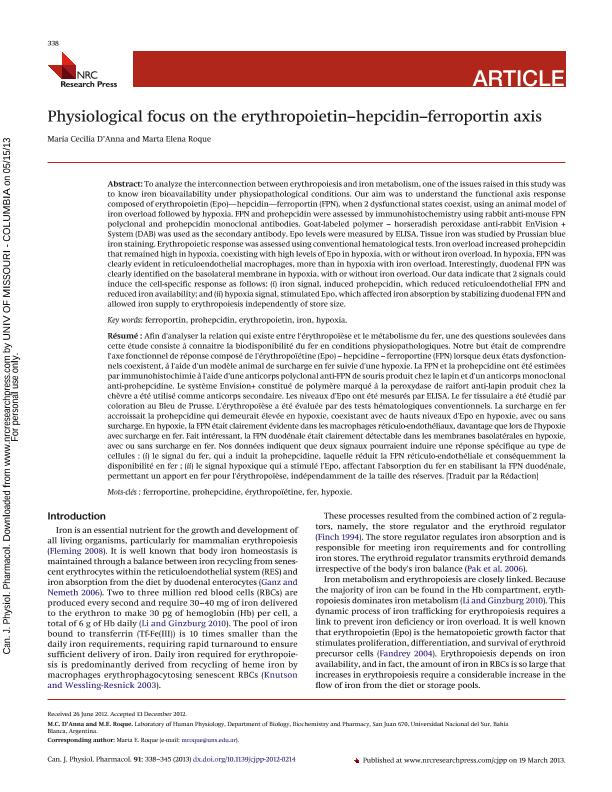Mostrar el registro sencillo del ítem
dc.contributor.author
D'anna, Maria Cecilia

dc.contributor.author
Roque, Marta Elena
dc.date.available
2016-12-28T15:55:48Z
dc.date.issued
2013-05
dc.identifier.citation
D'anna, Maria Cecilia; Roque, Marta Elena ; Physiological focus on the erythropoietin–hepcidin–ferroportin axis; Natl Research Council Canada-n R C Research Press; Canadian Journal Of Physiology And Pharmacology; 91; 5; 5-2013; 338-345
dc.identifier.issn
0008-4212
dc.identifier.uri
http://hdl.handle.net/11336/10438
dc.description.abstract
To analyze the interconnection between erythropoiesis and iron metabolism, one of the issues raised in this study was to know iron bioavailability under physiopathological conditions. Our aim was to understand the functional axis response composed of erythropoietin (Epo)—hepcidin—ferroportin (FPN), when 2 dysfunctional states coexist, using an animal model of iron overload followed by hypoxia. FPN and prohepcidin were assessed by immunohistochemistry using rabbit anti-mouse FPN polyclonal and prohepcidin monoclonal antibodies. Goat-labeled polymer − horseradish peroxidase anti-rabbit EnVision + System (DAB) was used as the secondary antibody. Epo levels were measured by ELISA. Tissue iron was studied by Prussian blue iron staining. Erythropoietic response was assessed using conventional hematological tests. Iron overload increased prohepcidin that remained high in hypoxia, coexisting with high levels of Epo in hypoxia, with or without iron overload. In hypoxia, FPN was clearly evident in reticuloendothelial macrophages, more than in hypoxia with iron overload. Interestingly, duodenal FPN was clearly identified on the basolateral membrane in hypoxia, with or without iron overload. Our data indicate that 2 signals could induce the cell-specific response as follows: (i) iron signal, induced prohepcidin, which reduced reticuloendothelial FPN and reduced iron availability; and (ii) hypoxia signal, stimulated Epo, which affected iron absorption by stabilizing duodenal FPN and allowed iron supply to erythropoiesis independently of store size.
dc.format
application/pdf
dc.language.iso
eng
dc.publisher
Natl Research Council Canada-n R C Research Press

dc.rights
info:eu-repo/semantics/openAccess
dc.rights.uri
https://creativecommons.org/licenses/by-nc-sa/2.5/ar/
dc.subject
Ferroportin
dc.subject
Prohepcidin
dc.subject
Erythropoietin
dc.subject
Iron
dc.subject
Hipoxia
dc.subject.classification
Bioquímica y Biología Molecular

dc.subject.classification
Medicina Básica

dc.subject.classification
CIENCIAS MÉDICAS Y DE LA SALUD

dc.title
Physiological focus on the erythropoietin–hepcidin–ferroportin axis
dc.type
info:eu-repo/semantics/article
dc.type
info:ar-repo/semantics/artículo
dc.type
info:eu-repo/semantics/publishedVersion
dc.date.updated
2016-12-22T20:37:07Z
dc.identifier.eissn
1205-7541
dc.journal.volume
91
dc.journal.number
5
dc.journal.pagination
338-345
dc.journal.pais
Canadá

dc.journal.ciudad
Otawa
dc.description.fil
Fil: D'anna, Maria Cecilia. Universidad Nacional del Sur. Departamento de Biología, Bioquímica y Farmacia; Argentina. Consejo Nacional de Investigaciones Científicas y Técnicas; Argentina
dc.description.fil
Fil: Roque, Marta Elena . Universidad Nacional del Sur. Departamento de Biología, Bioquímica y Farmacia; Argentina
dc.journal.title
Canadian Journal Of Physiology And Pharmacology

dc.relation.alternativeid
info:eu-repo/semantics/altIdentifier/url/http://www.nrcresearchpress.com/doi/abs/10.1139/cjpp-2012-0214#.WGLTM_nhCJA
dc.relation.alternativeid
info:eu-repo/semantics/altIdentifier/url/http://dx.doi.org/10.1139/cjpp-2012-0214
Archivos asociados
